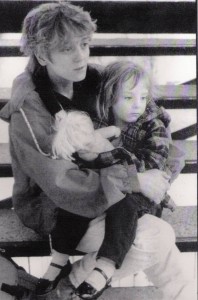 The unrelenting sadness and hopelessness that characterized my experience with depression is something I will never forget. In the grips of depression I often felt paralyzed, not possessing the strength to rise from bed or even to open my eyes in the morning. I felt completely alone, unable to make contact with anyone, not even Almighty God.
The unrelenting sadness and hopelessness that characterized my experience with depression is something I will never forget. In the grips of depression I often felt paralyzed, not possessing the strength to rise from bed or even to open my eyes in the morning. I felt completely alone, unable to make contact with anyone, not even Almighty God.
I lost interest in life and the things that make life special. I became reclusive and withdrawn, not wanting to be with friends I alternated between insomnia and exhaustion. I couldn’t concentrate. And always, I felt inexplicably sad. Nothing made me happy. Most frightening of all, I made intricate preparations for my death. 1
This year, 17 million Americans will suffer from depressive illness. In 1988 the General Accounting Office estimated that up to half of the homeless suffer from chronic psychiatric disorders. 2 – many also addicted to alcohol and drugs. While severe forms of psychosis are readily recognized, depressive disorders, which are more subtle, can be overlooked as factors that prevent program participants from moving forward in recovery.
People with a depressive illnesses cannot simply “pull themselves together” and get better. Without treatment, their symptoms can last for weeks, months, or years. Depressive disorders include; major depression, dysthymia (a less severe type of depression), and bipolar disorder, formerly called manic- depression. People with bipolar disorders have alternating cycles of depression and elation (or mania). In the depressed cycle, they experience many of the symptoms of depression; persistent sadness, feelings of hopelessness, pessimism, insomnia, fatigue, thoughts of death or suicide; difficulty concentrating, headaches and digestive disorders. Symptoms of the manic cycle include; inappropriate elation or irritability, grandiose notions, increased talking, disconnected and racing thoughts, markedly increased energy, poor judgment and inappropriate social behavior.
While often inherited, depressive disorders occur in people with no family history of problems. Genetic, psychological, and environmental factors all contribute to the onset of a depressive disorder. A serious loss, chronic illness, difficult relationship, financial problem, and unwelcome change in life patterns (like becoming homeless) also trigger depressive episodes. The root cause of these illnesses is usually physiologial, having too little or too much of certain neuro-chemicals, especially the compound called serotonin.
Specific Suggestions for Helping Residents with Depression
- Evaluation from a Medical Professional– This is important because certain medications and health problems cause symptoms of depression.
- Get the Proper Treatment – This usually involves a combination of antidepressant medications and psychotherapy.
- Monitor Medications – Though not habit-forming, antidepressant drugs must be carefully monitored. People suffering from depressive disorders often forget their medications or stop them taking without consent of a doctor. For bipolar disorder or chronic major depression, medication may have to become part of everyday life.
- Provide emotional support — Provide lots of understanding, patience, and encouragement. Be a good listener and remind them that they will feel eventually better. Don’t expect them to take on a lot responsibility or make too many decisions until after the depression has lifted. Watch for remarks about suicide and report them to their therapists.
- Engage Them in Constructive Activities – This could include taking walks and participating in activities such as hobbies, sports, and spiritual activities. While they need diversion and company, too many demands can increase their feelings of failure.
People can recover from depressive illnesses, if they get the right help. Here’s how one person describes his own recovery:
I am able to maintain my sanity through prayer, studying the Word, honest sharing with close friends, the support of both a counselor and a pastor, regular exercise, good eating habits, and an antidepressant drug which boosts my serotonin levels. None of these things by themselves was enough, in my case, to create balance in my emotional life. But taken as a package, they have each played a part in the restoration of my sanity and in making me a strong and productive part of the body of Christ. 3
For more information go to:
- National Institute of Mental Health
- National Alliance for the Mentally Ill
- Depression and Bipolar Support Alliance
- International Foundation for Research and Education on Depression
- National Alliance on Mental Health
1 Missionary Charlie Lehardy shared his experience with depression in STEPS magazine, quarterly journal of the National Association for Christian Recovery.
2 A Nation in Denial, Alice Baum and Donald Burnes, Westview Press, Boulder, CO, 1993
3 STEPS magazine
Much of the information in this article can from “Depression,” a National Institute of Mental Health publication

 I like to say, “There are reasons people become homeless – and there are reasons people stay homeless.” Some people come to shelters because of a short-term unfortunate circumstance; like losing a job, for instance. In this type of situation, temporary shelter and assistance is enough to help them to get back on their feet and move on with their lives. Sadly, it’s the chronically homeless who use most of the services available at shelters and rescue missions. For them, it is not just circumstances that keep them homeless – life controlling issues that must be addressed if they are to break the downward cycle. This is especially true for women who end up in family shelters. Here are a few counseling strategies that are absolutely essential if we are to bring real help to them.
I like to say, “There are reasons people become homeless – and there are reasons people stay homeless.” Some people come to shelters because of a short-term unfortunate circumstance; like losing a job, for instance. In this type of situation, temporary shelter and assistance is enough to help them to get back on their feet and move on with their lives. Sadly, it’s the chronically homeless who use most of the services available at shelters and rescue missions. For them, it is not just circumstances that keep them homeless – life controlling issues that must be addressed if they are to break the downward cycle. This is especially true for women who end up in family shelters. Here are a few counseling strategies that are absolutely essential if we are to bring real help to them. One of the surest signs that addicts are moving toward recovery is the return of their emotions. Once active use stops, their feelings are allowed to rise to the surface, often for the first time in many, many years. This period can be one of the most exciting – and one of the most dangerous – of early recovery. Without proper support, it is easy to fall back on their drug of choice to bring things ‘back under control.” Additionally, even if they don’t go back to intoxicants, there is also a concern that they might engage in other compulsive activities in order to circumvent the difficult process of returning to emotional health.
One of the surest signs that addicts are moving toward recovery is the return of their emotions. Once active use stops, their feelings are allowed to rise to the surface, often for the first time in many, many years. This period can be one of the most exciting – and one of the most dangerous – of early recovery. Without proper support, it is easy to fall back on their drug of choice to bring things ‘back under control.” Additionally, even if they don’t go back to intoxicants, there is also a concern that they might engage in other compulsive activities in order to circumvent the difficult process of returning to emotional health.

